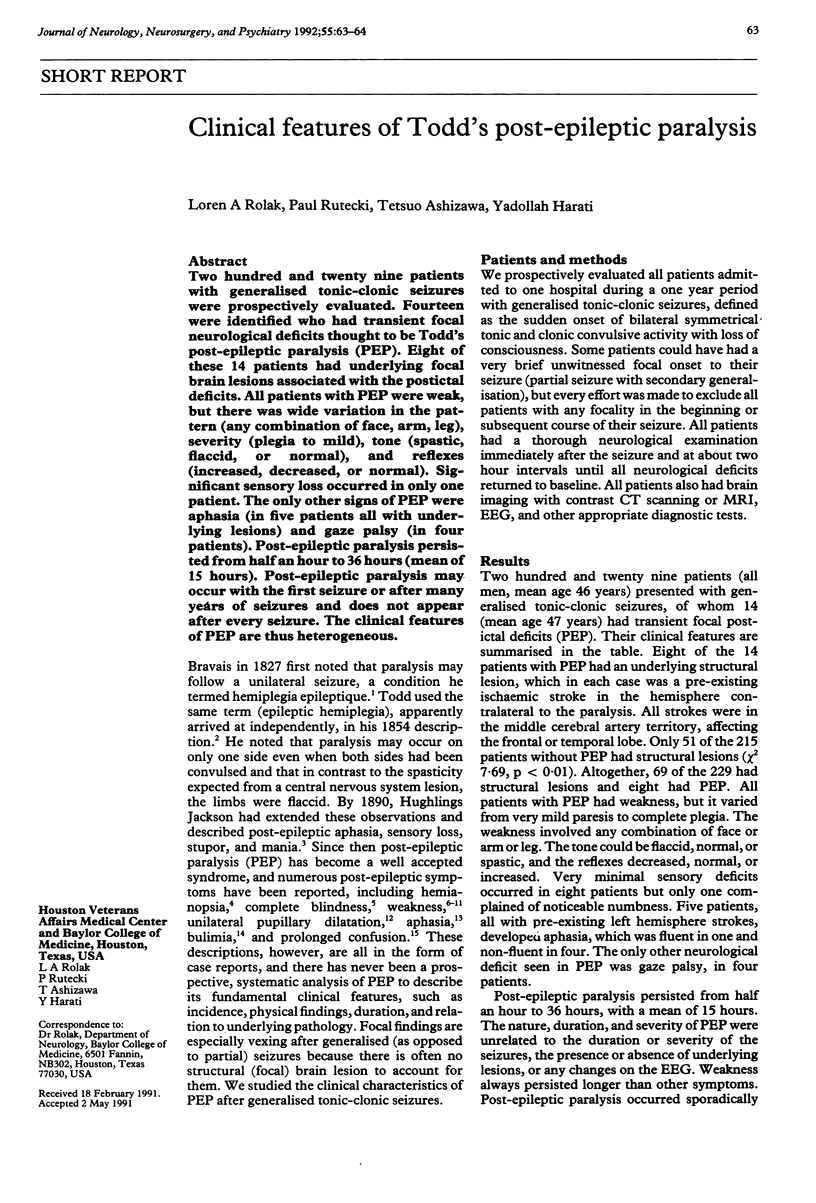Abstract
Two hundred and twenty nine patients with generalised tonic-clonic seizures were prospectively evaluated. Fourteen were identified who had transient focal neurological deficits thought to be Todd's post-epileptic paralysis (PEP). Eight of these 14 patients had underlying focal brain lesions associated with the postictal deficits. All patients with PEP were weak, but there was wide variation in the pattern (any combination of face, arm, leg), severity (plegia to mild), tone (spastic, flaccid, or normal), and reflexes (increased, decreased, or normal). Significant sensory loss occurred in only one patient. The only other signs of PEP were aphasia (in five patients all with underlying lesions) and gaze palsy (in four patients). Post-epileptic paralysis persisted from half an hour to 36 hours (mean of 15 hours). Post-epileptic paralysis may occur with the first seizure or after many years of seizures and does not appear after every seizure. The clinical features of PEP are thus heterogeneous.
Full text
PDF

Selected References
These references are in PubMed. This may not be the complete list of references from this article.
- Biton V., Gates J. R., dePadua Sussman L. Prolonged postictal encephalopathy. Neurology. 1990 Jun;40(6):963–966. doi: 10.1212/wnl.40.6.963. [DOI] [PubMed] [Google Scholar]
- Collier H. W., Engelking K. Todd's paralysis following an interscalene block. Anesthesiology. 1984 Sep;61(3):342–343. doi: 10.1097/00000542-198409000-00018. [DOI] [PubMed] [Google Scholar]
- EFRON R. Post-epileptic paralysis: theoretical critique and report of a case. Brain. 1961 Sep;84:381–394. doi: 10.1093/brain/84.3.381. [DOI] [PubMed] [Google Scholar]
- Gadoth N., Margalith D., Bechar M. Unilateral pupillary dilatation during focal seizures. J Neurol. 1981;225(3):227–230. doi: 10.1007/BF00313753. [DOI] [PubMed] [Google Scholar]
- Koerner M., Laxer K. D. Ictal speech, postictal language dysfunction, and seizure lateralization. Neurology. 1988 Apr;38(4):634–636. doi: 10.1212/wnl.38.4.634. [DOI] [PubMed] [Google Scholar]
- Kosnik E., Paulson G. W., Laguna J. F. Postictal blindness. Neurology. 1976 Mar;26(3):248–250. doi: 10.1212/wnl.26.3.248. [DOI] [PubMed] [Google Scholar]
- Remick R. A., Jones M. W., Campos P. E. Postictal bulimia. J Clin Psychiatry. 1980 Jul;41(7):256–256. [PubMed] [Google Scholar]
- Salmon J. H. Transient postictal hemianopsia. Arch Ophthalmol. 1968 May;79(5):523–525. doi: 10.1001/archopht.1968.03850040525004. [DOI] [PubMed] [Google Scholar]
- Yarnell P. R., Burdick D., Sanders B., Stears J. Focal seizures, early veins, and increased flow. A clinical, angiographic, and radioisotopic correlation. Neurology. 1974 Jun;24(6):512–516. doi: 10.1212/wnl.24.6.512. [DOI] [PubMed] [Google Scholar]
- Yarnell P. R. Todd's paralysis: A cerebrovascular phenomenon? Stroke. 1975 May-Jun;6(3):301–303. doi: 10.1161/01.str.6.3.301. [DOI] [PubMed] [Google Scholar]
- Youkey J. R., Clagett G. P., Jaffin J. H., Parisi J. E., Rich N. M. Focal motor seizures complicating carotid endarterectomy. Arch Surg. 1984 Sep;119(9):1080–1084. doi: 10.1001/archsurg.1984.01390210074016. [DOI] [PubMed] [Google Scholar]


